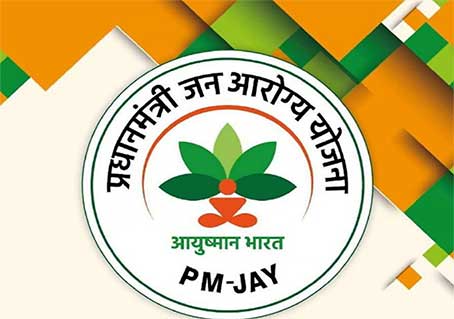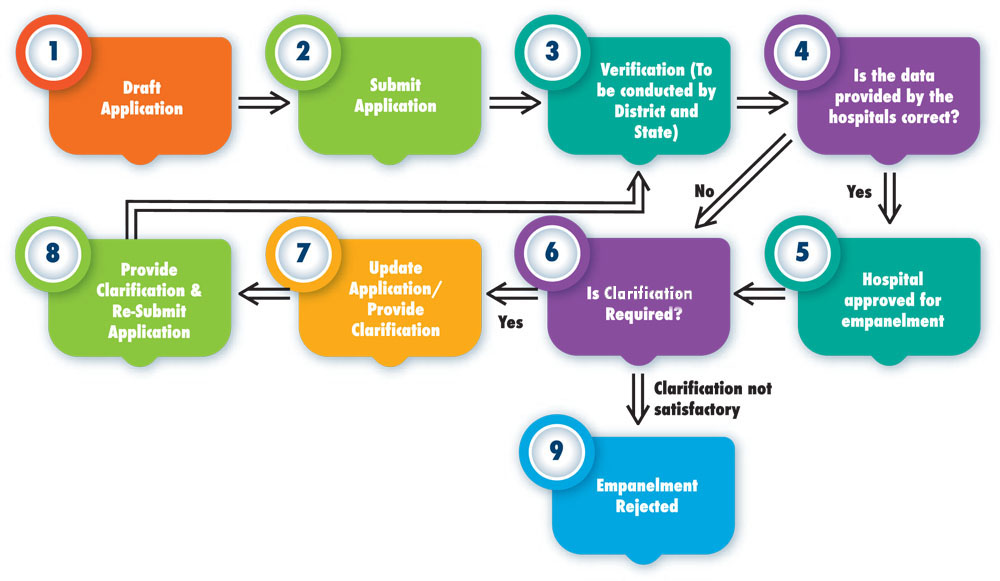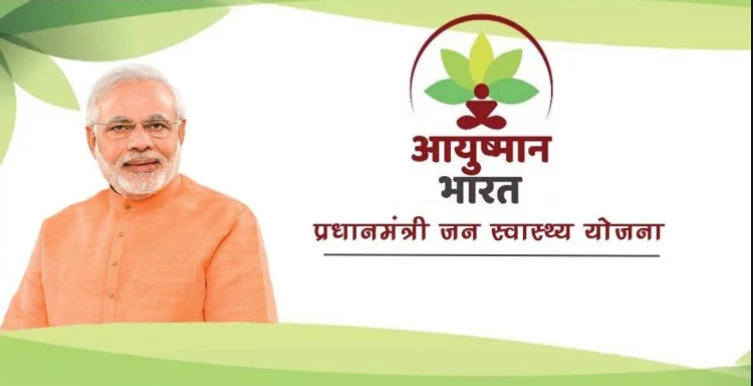PM-JAY: The various States have developed their own health insurance/assurance plans utilizing a variety of different approaches. Several of them utilize the services of insurance companies, while others operate the schemes directly in their States.
Due to the fact that States are at diverse levels of preparedness and have varying capacities to run such schemes, PM-JAY allows States to choose their implementation model. They may implement systems using an assurance/trust approach, an insurance model, or a combination of the two.
A. Assurance Model/Trust Model
This is the most often used implementation model by the majority of States. Under this arrangement, the SHA implements the program directly, without the insurance company’s involvement. In this paradigm, the government bears the financial risk associated with administering the scheme. SHA pays health care providers directly. Despite the absence of an insurance provider, the SHA retains the services of an Implementation Support Agency (ISA) to manage claims and related tasks. Due to the absence of an insurance company, the SHA is also responsible for performing specialized activities such as hospital empanelment, beneficiary identification, claims management and audits, and other associated responsibilities.
B. Insurance Model
In the insurance model, the SHA selects an insurance company to manage PM-JAY in the State through a competitive tendering procedure. SHA pays a premium to the insurance company per qualifying family for the policy period based on a market-determined premium, and the insurance company handles claims and reimbursements to the service provider. In this scenario, the insurance company also bears the financial risk associated with administering the scheme. To ensure that the insurance company does not profit excessively, the scheme allows for a method in which insurance companies can receive only a set amount of the premium for-profit and administrative expenditures.
After deducting a fixed proportion for administration charges (including all costs excluding service tax and any relevant cess), and after satisfying all claims, if there is a surplus, the insurer should refund the SHA 100 percent of the remaining surplus within 30 days. The percentage that must be refunded is as follows:
a. In Category A States (administrative cost cannot exceed 20%)
- i. Administrative cost allowed 10% if claim ratio less than 60%.
- ii. Administrative cost allowed 15% if claim ratio is between 60 to less than 70%.
- iii. Administrative cost allowed 20% if claim ratio is between 70 to less than 80%.
b. In Category B States (administrative cost cannot exceed 15%)
- i. Administrative cost allowed 10% if claim ratio less than 60%.
- ii. Administrative cost allowed 12% if claim ratio is between 60 to less than 70%.
- iii. Administrative cost allowed 15% if claim ratio is between 70 to less than 85%.
If the claim settlement ratio reaches 120 percent (115 percent for the Category B States) during any policy period, the excess sum shall initially be paid equally between the insurance carrier and the State Government / Union Territory. Following that, the Central Government shall divide the burden in accordance with the sharing pattern ratio from the excess burden amount carried by the State Government / Union Territory. However, the overall contribution of the Central Government, including the premium share and excess burden amount of the claim, shall not exceed the Central Government’s maximum share ceiling applicable to that state / UT. Any amount in excess of the Central and State Government contributions shall be borne by the insurance company.
C. Mixed Model
The SHA utilizes both the assurance/trust and insurance models stated above in a variety of capacities to increase economic and operational efficiency, flexibility, and convergence with the State system. This concept is typically used by brownfield states that already had plans in place that covered a wider population of beneficiaries.
Financing of The Scheme
PM-JAY is entirely government-funded, with costs divided between the Central and State Governments. The Government of India establishes a national ceiling amount per family, which is utilized to calculate the contribution’s maximum limit. The actual premium discovered through the open tendering process or the maximum ceiling on the estimated premium determined by the Government of India for the implementation of PM-JAY, whichever is less, would be shared between the Central Government and States/UTs in the ratio specified in extant Ministry of Finance directives from time to time. Additionally, administrative costs associated with executing the scheme at the State level are covered by the scheme and divided equally between the Centre and the State.
For States (other than the North-Eastern States and three Himalayan States) and Union Territories with legislatures, the existing sharing system is 60:40. The ratio is 90:10 for the North-Eastern states and three Himalayan states (Jammu & Kashmir, Himachal Pradesh, and Uttarakhand). The Central Government may contribute up to 100% of funding to Union Territories without legislatures on a case-by-case basis.
- Insurance model – The State Government pays a flat premium per family, regardless of the number of persons covered by PM-JAY in that family, which is then distributed to the insurer based on the number of qualified families.
- Assurance model – The central share of the contribution is calculated on the basis of actual claim costs or the ceiling, whichever is lower. If the State employs an Implementation Support Agency, the cost of the ISA, which is chosen through a competitive process, is likewise split between the Centre and the State.
Expansion of Coverage By States Under PM-JAY, Convergence, and Flexibility to The States

Over the last couple of decades, different states have implemented their own health insurance/assurance programs. The majority of these plans cover only tertiary care issues. Except for a few minor states that have impaneled a few hospitals outside of their borders, these schemes provide benefits primarily within their borders. Only a few States had merged their schemes with the defunct RSBY program, and the majority of them continued to operate separately. This was owing to the RSBY’s lack of flexibility in design, which originally aided in rapid scale-up but became a challenge over time and provided the States with limited flexibility.
Even though these programs targeted the poor and disadvantaged, eligibility requirements and databases varied significantly between states. Few states made use of the food subsidy database, while others established their own for their welfare programs.
PM-key JAY’s objectives were to assure comprehensive coverage for catastrophic illnesses, reduce catastrophic out-of-pocket expenses, increase access to inpatient treatment, reduce unmet needs, and consolidate diverse health insurance systems across the States. Additionally, PM-JAY would set national standards for a health assurance system and will facilitate care portability across borders.
In the spirit of cooperative federalism and in consideration of regional variances, the PM-JAY design incorporates a great deal of flexibility. As a result, PM-JAY affords States considerable freedom in terms of scheme design and implementation.
States have been provided the flexibility in terms of the following parameters:
- Mode of implementation – States have the option of implementing the plan through a trust, an insurance firm, or a mixed model.
- Usage of beneficiary data – PM-JAY targets beneficiaries using SECC data; however, states have been given leeway to choose the dataset for this purpose if they cover more beneficiaries than the SECC-defined numbers. However, the state must verify that all beneficiaries who are qualified based on SECC data are covered.
- Co-branding – States may co-brand their existing health insurance/assurance programs with PM-JAY in accordance with the scheme’s co-branding requirements.
- Expansion of coverage to more people – States may encompass additional families than those specified by SECC data. The States will be responsible for the whole expense of these new families.
- Increasing benefit cover to higher value – If the State so wants, they may even increase the annual benefits cap to ‘5 lakh per family. However, in this instance, the State must bear the entire expense of additional coverage.
- Revision in package numbers and pricing – PM-JAY insures approximately 1300 packages at NHA-set rates. However, in light of the varied illness profiles and cost of services between States, States have been given the flexibility to expand the number of packages and, within certain limits, to alter package costs.
- Reservation of packages for public hospitals – To ensure that such services, which are capable of being delivered well by government health facilities, are not abused by private providers, the NHA has developed a set of standards that apply only to public health care institutions. States have the authority to alter the list of such ailments reserved for public hospitals.
- IT Systems – Prior to the implementation of PM-JAY, some states operated their own health insurance programs and maintained their own information technology infrastructure. PM-JAY offers states the freedom to continue using their own IT systems while sharing data with NHA in the defined format in real-time.
- Payment to public hospitals – States have also been given the option of deducting a percentage of the amount of the claim paid to public hospitals.
Hospital Empanelment
To deliver the advantages under PM-JAY, the supply of health care services must be ensured by pre-selected, well-equipped, and well-prepared facilities. In addition, hospitals must be dispersed sufficiently enough across the country to provide optimal accessibility to eligible families.
To meet the increased demand under PM-JAY while also ensuring high-quality care for the beneficiaries, it is critical to maintain and expand a network of hospitals that meet quality standards and requirements. This necessitates the pre-empanelment of hospitals so that beneficiaries can be assured that their rights will be honored in the most convenient, cashless, and high-quality manner possible.

Empanelment Criteria
Two types of empanelment criteria have been developed based on supply-side characteristics (almost 71% of hospitals operate as sole proprietorship enterprises with fewer than 25 beds capacity and provide non-specialized general clinical care). These criteria were developed based on previous experience with other government-funded health insurance plans, state-specific quality-of-care standards, and the Clinical Establishment Act of 2011.
The detailed criteria for empanelment are available on www.pmjay.gov.in
- General criteria – For hospitals that provide non-specialized general medical and surgical care with or without ICU and emergency services.
- Special Criteria (for clinical specialties) – A set of criteria has been established for each specialty. A hospital is not allowed to choose the risk under PM-JAY, which means it cannot apply for specific specialties and must agree to provide all specializations to PM-JAY beneficiaries. However, in order to provide a specialized clinical service, the hospital must have the appropriate infrastructure and human resources in place, as outlined in the PM-JAY special criteria.
Process of hospital empanelment in PM-JAY
For all aspects of the procedure, PM-JAY recommends a two-tier approach to hospital empanelment that is online, transparent, efficient, and fully free. States are in charge of the entire hospital empanelment procedure, and they have final decision-making authority in this respect. A State Empanelment Committee (SEC) has been established under the State Health Agency at the state level. A District Empanelment Committee (DEC) has been established at the district level.
Each impaneled hospital must establish a dedicated support desk for beneficiaries, which will be staffed by a dedicated team of employees designated by the Empanelled Health Care Provider (EHCP). These help desk employees are known as Pradhan Mantri Arogya Mitras (PMAMs), and their job is to make it easier for beneficiaries to receive care at hospitals. Every impaneled hospital is likewise assigned a unique ID.
- Hospitals must submit an application online, which is free of charge. The application’s progress can also be tracked online.
- The online applications are scrutinized by the DEC and physical verification of the hospitals is carried out.
- Following this verification, the DEC makes a recommendation to the SEC on whether or not to approve or reject the hospital. The SEC is the one who makes the final judgment on empanelment.
Continuous quality improvement and other incentives to impaneled hospitals
PM-JAY encourages impaneled hospitals to strive for improved quality standards on an ongoing basis. These incentives will undoubtedly motivate hospitals to meet the stated quality criteria. Over and above the package rates, hospitals are eligible for the following incentives under PM-JAY.
- A hospital does not have to be NABH accredited at the time of empanelment, but if it achieves entry-level NABH certification during its relationship with PM-JAY, it will be paid 10% more in package rates. Similarly, a hospital that receives complete accreditation is paid 15% more.
- Hospitals attached to teaching institutions (medical, PG, and DNB courses) are entitled to 10 percent higher packages.
- In order to encourage hospitals to extend out to beneficiaries in underserved areas, PM-JAY has set a 10% higher package fee for hospitals located in aspirational districts.
National Health Care Providers (NHCP)
Despite the fact that states are responsible for hospital empanelment, there are several outstanding tertiary and specialized care hospitals that function as independent institutions of excellence under the Ministry of Health and Family Welfare (MoHFW) or another department. AIIMS, Safdarjang Hospital, JIPMER, PGI Chandigarh, and others are some of the most well-known instances of such hospitals.
The National Health Authority (NHA) has directly appointed these hospitals by signing a Memorandum of Understanding with each of them. To expand the network of service providers, NHA has directly impaneled all NABH-recognized private hospitals in the National Capital Region (NCR). Empanelment of government hospitals other than those controlled by the Ministry of Health and Family Welfare is also a significant step toward expanding the hospital network.

